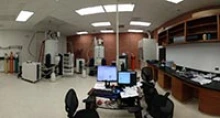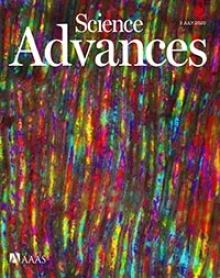UArizona Researchers Detangle Protein Interaction Implicated in Down Syndrome and Alzheimer’s
New findings by University of Arizona College of Medicine – Tucson chemists Drs. Wolfgang Peti and Rebecca Page provide a foundation to better understand and treat these neurological disorders.

TUCSON, Ariz. – From the movement of a finger to the creation of a memory, actions of the human body require the harmonious concert of protein interactions. A system of checks and balances ensures proper coordination of biomolecules, but when the scale is tipped, lopsided molecular relationships can lead to disorders and diseases. Discovering how proteins interact with one another under ideal conditions is critical to understand what goes awry in disease states, and to inform novel prevention and treatment strategies.

The powerful biomolecular NMR spectrometers at the University of Arizona have allowed scientists to gain molecular details of the interaction between RCAN1 and calcineurin, two proteins that have long been implicated in Down syndrome and Alzheimer's disease. (Photo: University of Arizona)
“We had to develop a hybrid technology that combines two powerful chemistry techniques to be able to obtain the structures of these proteins that would help us understand their interaction,” Dr. Peti said.
The researchers’ findings, published this month in Science Advances, provide a foundation to better understand and treat several neurological disorders.
Calcineurin, or CN, is a key regulator of several biological processes, including human development. Over-inhibition of this protein plays a critical role in the phenotype of Down syndrome, a genetic disorder caused by an abnormal event during development that results in an extra chromosome 21.

Wolfgang Peti, PhD
According to the National Institute on Aging, many individuals with Down syndrome are diagnosed with early-onset Alzheimer’s disease by age 40, and a study published in the Archives of Neurology, now JAMA Neurology, found that nearly three-fourths of those with Down syndrome had developed dementia by age 60. RCAN1 is also overactive in this neurodegenerative disease.
Researchers have known that an unbalanced relationship between CN and RCAN1 has profound consequences on the brain, but it was previously unknown how RCAN1 intimately interacts with and regulates CN. Because the structure of a protein determines its function, Dr. Peti needed to get a “molecular picture” of the two proteins to understand the mechanism by which RCAN1 inhibits CN.
To achieve this goal, the team utilized two advanced techniques: crystallography and nuclear magnetic resonance spectroscopy. Through crystallography, structures of proteins can be determined by studying the fundamental arrangement of their most basic components – atoms – in crystalline solids. Nuclear magnetic resonance spectroscopy is a technique often used to determine the content and purity of a sample, as well as a molecular structure.

Rebecca Page, PhD
“We’re not the first group to study (the interaction) structurally,” Dr. Page said. “It really required a combination of methods in order to get to our level of understanding of how this actually functions.”
Drs. Peti and Page, both members of the university’s BIO5 Institute, give much of the credit to assistant research scientist and first author on the Science Advances paper Yang Li, who Dr. Page called an “invaluable powerhouse” that made the discovery possible.
“It’s really been a tour-de-force. It’s required a huge amount of effort to really detangle how these proteins function,” Dr. Page said.

Click to view paper.
The group found that RCAN1 inhibits CN by impairing its ability to signal to other proteins and by blocking the active site as well as the substrate recruitment sites of the protein. By inhibiting the activity of CN in two different ways, RCAN1 effectively prevents CN from supporting proper development and cognitive function. This interaction also helps to explain how the overactivity of RCAN1 contributes to Down syndrome and Alzheimer’s disease.
With this new information, researchers may now be able to develop targeted drugs to disrupt the imbalanced interaction between RCAN1 and CN.
“We are hopeful that findings from this study will inform new therapies to treat or entirely prevent these neurological disorders,” Dr. Peti said.
# # #
A version of this article appeared originally on the UANews website.
NOTE: Photos available upon request.
About the University of Arizona Health Sciences
The University of Arizona Health Sciences is the statewide leader in biomedical research and health professions training. UArizona Health Sciences includes the Colleges of Medicine (Tucson and Phoenix), Nursing, Pharmacy, and the Mel and Enid Zuckerman College of Public Health, with main campus locations in Tucson and the Phoenix Biomedical Campus in downtown Phoenix. From these vantage points, Health Sciences reaches across the state of Arizona, the greater Southwest and around the world to provide next-generation education, research and outreach. A major economic engine, Health Sciences employs nearly 5,000 people, has approximately 4,000 students and 900 faculty members, and garners $200 million in research grants and contracts annually. For more information: uahs.arizona.edu (Follow us: Facebook | Twitter | YouTube | LinkedIn | Instagram).
About the University of Arizona
The University of Arizona, a land-grant university with two independently accredited medical schools, is one of the nation's top public universities, according to U.S. News & World Report. Established in 1885, the university is widely recognized as a student-centric university and has been designated as a Hispanic Serving Institution by the U.S. Department of Education. The university ranked in the top 20 in 2018 in research expenditures among all public universities, according to the National Science Foundation, and is a leading Research 1 institution with $687 million in annual research expenditures. The university advances the frontiers of interdisciplinary scholarship and entrepreneurial partnerships as a member of the Association of American Universities, the 65 leading public and private research universities in the U.S. It benefits the state with an estimated economic impact of $4.1 billion annually. For more information: arizona.edu (Follow us: Facebook | Twitter | YouTube | LinkedIn | Instagram).

